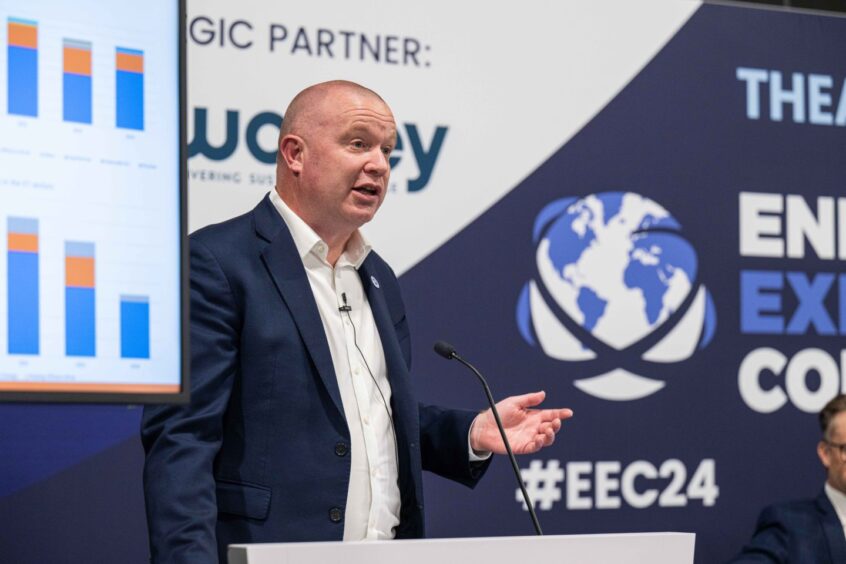 © Supplied by The Energy Industrie
© Supplied by The Energy Industrie It may seem like an uncertain world just now, but the market for energy exports remains robust.
-
Some Energy Voice online content is funded by outside parties. The revenue from this helps to sustain our independent news gathering. You will always know if you are reading paid-for material as it will be clearly labelled as “Partnership” on the site and on social media channels,
This can take two different forms.
“Presented by”
This means the content has been paid for and produced by the named advertiser.“In partnership with”
This means the content has been paid for and approved by the named advertiser but written and edited by our own commercial content team.
Thousands of projects worth trillions of dollars in capital expenditure offer huge potential to Scottish businesses. Those opportunities span every sector from oil and gas to renewables and countries on every continent.
How to make the most of that vast market will be the subject of the upcoming Energy Exports Conference at P&J Live in Aberdeen on June 3 and 4. The Energy Industries Council event will allow delegates to connect with international operators, developers, contractors, government and export advisors, ambassadors and trade experts from across the globe.
So what’s at stake in the global energy market?
The $16 trillion opportunity
Here in the UK things can move slowly with a frustrating inconsistency on policy in the energy sector. But Neil Golding, Director of Market Intelligence at EIC, pointed to a far more positive environment globally.
He said: “There’s potential for 15,000 energy projects around the globe to move forward with around $16 trillion worth of capital expenditure. These are real opportunities as opposed to the pipedreams we can sometimes see in the UK.
“There are significant opportunities across all of the energy sectors. We’ve seen already this year, for example, some noticeable final investment decisions that have been reached within the hydrogen sector and the upstream oil and gas sector.
“In terms of hydrogen, large projects include Germany, the US and the Netherlands. For upstream oil and gas, we’ve seen some sizeable final investment decisions made in the Middle East in Qatar, in Latin America, in Brazil and also in the AIPAC region in Indonesia, Malaysia and Australia.
“So, whilst there are struggles certainly within the UK, offshore oil and gas elsewhere is still seeing some significant investments.”
Strengths and challenges in the UK
The UK and Scotland in particular have huge advantages when it comes to experience in the energy sector and the skills required to flourish both in oil and gas and renewables.
Neil added: “Our capabilities are wanted in the midstream and also downstream oil and gas sectors.
“Of course, we also have capabilities within the offshore wind sector and companies really want to learn from our expertise. They want to hear from the smaller organisations that have proven track records within each industry.
“When it’s hydrogen and carbon capture, it’s the same supply chain that’s effectively working already in the oil and gas industry. So, we have great capabilities that exist already within the UK supply chain that are easily transferred into those sectors.”
Rebecca Groundwater, EIC’s head of external affairs, added: “When you look at CCS or CCUS, it’s oil and gas that is the transferable market, with the geoscience aspect and offshore working.
“We’re yet to see the real breadth of skills that are required across some of the newer technologies. But given the supply chain is able to work across all of them, it’s then about how we make it work properly.
“That’s why the EEC is so good, because it brings everybody together from the supply chain and the global market and says, ‘Right, what can you do? How can we build the conversation going forward.’ It’s a great meeting point for all of these discussions.”
Overcoming market barriers
Bureaucratic hurdles can often hamper progress in the energy industry. But that’s not the case in many countries around the world.
Rebecca added: “In the UK the pace of project delivery and planning and regulation is very slow. Canada, for instance, is ahead on CCS. But there’s nothing stopping our global supply chain going to places like Canada.
“The Middle East is a very easy place to do business and we see our members going there before other markets.”
Neil concurred: “That is really supported by the data. They just move forward and they build the projects. So, you don’t have those barriers to investment. They’re not reliant upon subsidy mechanisms.”
A consistency of policy and long-term vision is also vital.
“The energy sector and policy can’t be made on a three or four-year timeline,” said Rebecca. “We can’t have shifting policies based on political allegiance. It needs to be a strategy that looks at 2050 and looks at where projects may come online and on what dates so that our supply chain can go, ‘Okay, I can build a business plan around that.’
Let EEC make you part of the global energy picture
The Energy Exports Conference is a gateway to international growth and success. It provides companies access to hundreds of contacts and enables businesses to learn about multiple new export opportunities.
Last year’s conference saw more than 1,200 registered companies attending with over 400 one-to-ones and more than 120 speakers.
Delegates this year will access advice and networking opportunities in every field from oil and gas, hydrogen and carbon capture, utilisation, and storage to wind, nuclear, sustainable aviation fuel and decommissioning.
Rebecca said: “The EEC is a great way to build a strategy for success in the global energy market. Being in touch and hearing about those global markets and the opportunities to network with companies who are already doing it is a great thing. Our regional directors can talk you through how to do it. The opportunity is absolutely there.”
To get the most out of the opportunities in the global energy market sign up to the Energy Exports Conference.



